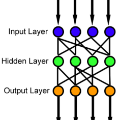Human gait can be a predictive factor for detecting pathologies that affect human locomotion according to studies. In addition, it is known that a high investment is demanded in order to raise a traditional clinical infrastructure able to provide human gait examinations, making them unaffordable for economically vulnerable patients. In face of this scenario, this work proposes an accessible and modern solution composed of a wearable device, to acquire 3D-accelerometer and 3D-gyroscope measurements, and machine learning techniques to classify between distinct categories of induced gait disorders. In order to develop the proposed research, it was created a dataset with the target label being 4 distinct and balanced categories of anomalous gait. The machine learning techniques that achieved the best performances (in terms of accuracy) in this dataset were through the application of Principal Component Analysis algorithm following of a Support Vector Machines classifier (94 \%). Further, an architecture based on a Feedforward Neural Network yielded even better results (96 \%). Finally, it is also presented computational performance comparison between the models implemented.
翻译:此外,已知需要大量投资,以提高传统的临床基础设施,使其能提供人类步态检查,使经济上脆弱的病人负担不起。面对这一假设,这项工作提议采用由可磨损装置构成的无障碍现代解决方案,以获得3D加速计和3D陀螺仪测量,并采用机器学习技术,对不同类别的诱发性运动障碍进行分类。为了发展拟议的研究,它创建了一个数据集,目标标签为4个不同和平衡的异常行走类。在这一数据集中取得最佳性能(准确性)的机器学习技术是通过在支持矢量机分类器(94 ⁇ )之后应用主构件分析算法实现的。此外,基于Feedforward神经网络的建筑取得了更好的结果(96 ⁇ )。最后,它还介绍了所实施模型之间的计算性能比较。



